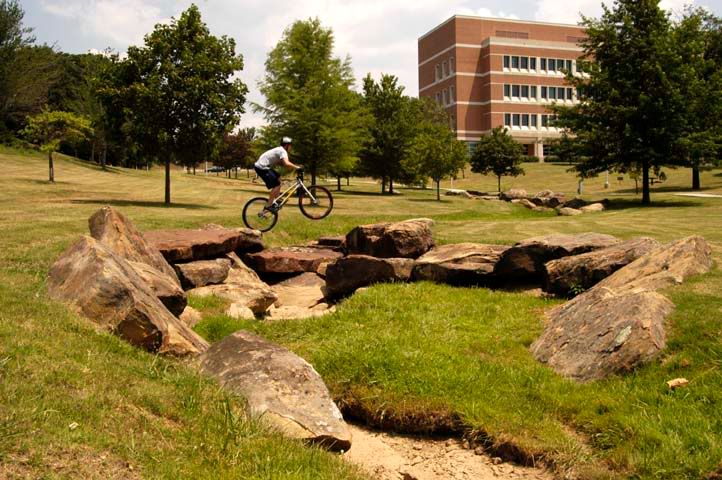Post by gulliver on Sept 11, 2003 20:15:40 GMT 8
Another article from Mountain Bike Action. Nakakatuwa ang rocky sections, even on a hard tail. a good front shock-fork helps you do it faster. 
How To Ride The Rocks--April'99
Nothing strikes as much fear into a rider as a rock garden. Rocks prove that Columbus was right_the world isn't flat. In fact, large sections of it are round. Climbing and descending through rocky sections can be treacherous. Falling onto hard, pointed objects is a painful way to find out that Queen Isabella was wrong.
Rock sections come in three versions: (1) loose, marble-covered pieces of trail; (2) jagged, embedded swaths of rock that don't move; (3) nasty stair steps that stretch the limits of balance. MBA will show you how to conquer each type of rock section, making you a better, bolder (or boulder) rider.
Fluid: Descending through a loose rock garden requires the rider to stand and stay fluid. Let the bike jerk around beneath you as your arms and legs soak up the movement. The key is to not tighten up and fight the bike. If you grab the bar with a death grip and spaz, you will fall. It is preferable to brake once you get through the section, but if it is so long that you need to slow down, drag the brakes from the top. Never lock up the rear wheel because it will skip and rebound off every rock, and if you aren't gentle on the front brake, the front wheel will be pushing and sliding against rocks.
Pick down: Descending over embedded rocks is easier than it appears. Find the straightest path with the least amount of bumps and go for it. In this case, speed and a straight front wheel are your friends. If you go too slow, either wheel can stop suddenly on the face of a rock, throwing you over the bars. If you turn your front wheel it will catch on the side of a rock and either slide out or, worse, jack-knife and pitch you over the bars. After the rider gets through this rocky section, he will scrub speed to a comfortable level in the little patch of dirt just in front of him, then attack the next section in the same manner.
Sit, maybe stand: Long, flat rock sections like this (picture not shown) require that you stay seated with an even cadence. As with descending, let the bike move under you and just keep pedaling smoothly, without sudden bursts. If the rider entered this section at speed and felt he was carrying enough momentum to make it through, he would stand and choose the straightest line without using the brakes.
Pick up: Climbing in embedded rocks requires patience and sure line choices. Stay seated and steer through the rocks, trying to find the straightest line with the least amount of rock hops. Staying seated gives you controlled power so you won't spin. Be sure to stay in a low enough gear that allows for quick spinning bursts if you have to hop over a rock.
Power up: Here, the rider is crouching over the tip of the saddle, elbows in, for the strongest burst of power. After staying seated and picking his way through the gravel, he wisely chose to climb the steeper pitch on solid rock. The superb traction of the rock face makes it safe (and necessary) to power ahead. Once past this short section, the rider will sit back down and resume spinning.

How To Ride The Rocks--April'99
Nothing strikes as much fear into a rider as a rock garden. Rocks prove that Columbus was right_the world isn't flat. In fact, large sections of it are round. Climbing and descending through rocky sections can be treacherous. Falling onto hard, pointed objects is a painful way to find out that Queen Isabella was wrong.
Rock sections come in three versions: (1) loose, marble-covered pieces of trail; (2) jagged, embedded swaths of rock that don't move; (3) nasty stair steps that stretch the limits of balance. MBA will show you how to conquer each type of rock section, making you a better, bolder (or boulder) rider.
Fluid: Descending through a loose rock garden requires the rider to stand and stay fluid. Let the bike jerk around beneath you as your arms and legs soak up the movement. The key is to not tighten up and fight the bike. If you grab the bar with a death grip and spaz, you will fall. It is preferable to brake once you get through the section, but if it is so long that you need to slow down, drag the brakes from the top. Never lock up the rear wheel because it will skip and rebound off every rock, and if you aren't gentle on the front brake, the front wheel will be pushing and sliding against rocks.
Pick down: Descending over embedded rocks is easier than it appears. Find the straightest path with the least amount of bumps and go for it. In this case, speed and a straight front wheel are your friends. If you go too slow, either wheel can stop suddenly on the face of a rock, throwing you over the bars. If you turn your front wheel it will catch on the side of a rock and either slide out or, worse, jack-knife and pitch you over the bars. After the rider gets through this rocky section, he will scrub speed to a comfortable level in the little patch of dirt just in front of him, then attack the next section in the same manner.
Sit, maybe stand: Long, flat rock sections like this (picture not shown) require that you stay seated with an even cadence. As with descending, let the bike move under you and just keep pedaling smoothly, without sudden bursts. If the rider entered this section at speed and felt he was carrying enough momentum to make it through, he would stand and choose the straightest line without using the brakes.
Pick up: Climbing in embedded rocks requires patience and sure line choices. Stay seated and steer through the rocks, trying to find the straightest line with the least amount of rock hops. Staying seated gives you controlled power so you won't spin. Be sure to stay in a low enough gear that allows for quick spinning bursts if you have to hop over a rock.
Power up: Here, the rider is crouching over the tip of the saddle, elbows in, for the strongest burst of power. After staying seated and picking his way through the gravel, he wisely chose to climb the steeper pitch on solid rock. The superb traction of the rock face makes it safe (and necessary) to power ahead. Once past this short section, the rider will sit back down and resume spinning.


















